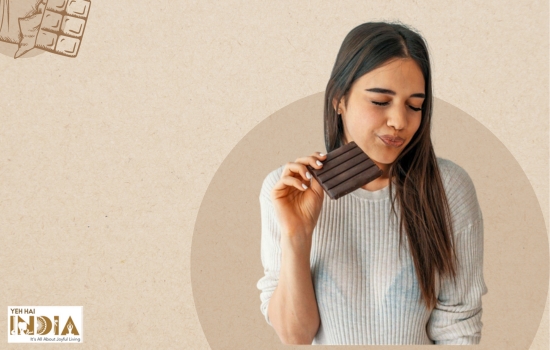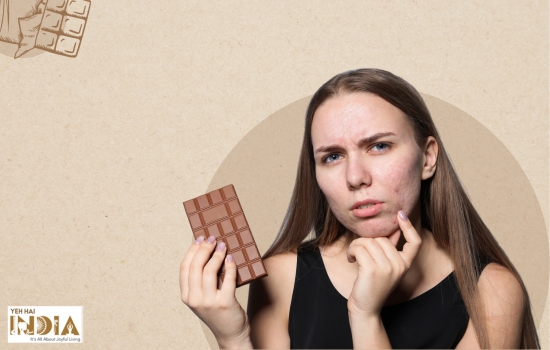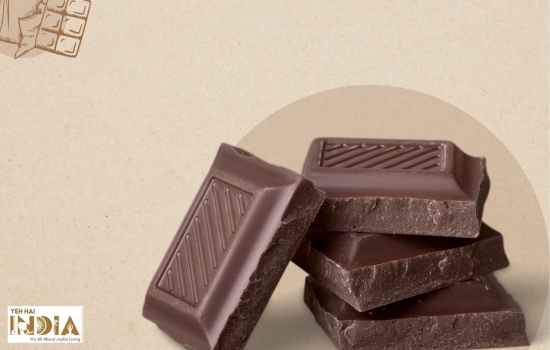Dark chocolate has long been a favourite pleasure for many, thanks to its creamy, velvety richness and somewhat bitter overtones. Chocolate has earned its place in the confectionary world, whether savoured as a refined delicacy or utilised as a soothing treatment after a long day.
What is Dark Chocolate?
Dark chocolate is a popular treat and is often enjoyed for its unique flavour and health benefits.
A type of chocolate, which is distinguished by its particular flavour profile, which is a balanced combination of rich cocoa and mild sweetness that gives rise to delightful sensory characteristics.
Composition: Cocoa solids, Cocoa butter, and Sugar
Colour: Dark brown (darker than milk chocolate)
Taste: Slightly bitter than regular chocolates
Nutritional Profile of Dark Chocolate

Dark chocolate, which is widely praised for its rich and complex flavour, receives distinguishing features from its composition, which is essential for appreciating the taste and associated nutritional benefits.
Cocoa Solids
Cocoa solids are the essence of dark chocolate, contributing to the rich chocolate flavour, and they are popularly known as cocoa mass.
They are made from ground cocoa beans and are high in antioxidants, notably flavonoids and polyphenols, which are linked to a variety of health benefits.
- Promotes heart health
- Boosts cognitive function
- Protects against oxidative stress
Cocoa solids are present in dark chocolate in varied percentages, which often range from 50% to 90%. A high amount of cocoa solid gives the chocolate a more intense flavour, leading to a slight bitterness, which is not necessarily enjoyed by everyone.
Cocoa Butter
Cocoa butter is the natural fat extracted from cocoa beans during processing.

The richness and smoothness of dark chocolate are enhanced by cocoa butter.
Despite being a saturated fat, cocoa butter contains a distinct fatty acid makeup that includes stearic acid, which is thought to be neutral or even potentially good for heart health.
Cocoa butter is a stable fat that forms the structure and flavour of dark chocolate.
The balance between cocoa solids and cocoa butter determines the texture and mouthfeel.
Sugar
Sugar is added to dark chocolate to balance out the bitterness coming from cocoa solids.
The sugar content of dark chocolate varies greatly with the brand and kind of chocolate being manufactured.
Dark chocolate has less sugar than milk chocolate or white chocolate, making it a good choice for individuals trying to cut back on sugar and lose weight.
Sugar increases the calorie content of dark chocolate, but at the same time, fibre and good fats from cocoa moderate its influence on the glycemic index.
Dark Chocolate vs. Other Chocolates
Dark chocolate differs significantly from its chocolate counterparts, such as milk chocolate and white chocolate. The primary distinctions include:
Characteristics Dark Chocolate Milk Chocolate White Chocolate Cocoa Solids Higher
(typically 50-90%)Lower
(typically 10-50%)Minimal
(usually 0%)Cocoa Butter Significant Moderate High Sugar Content Lower than milk chocolate
(varies widely)Higher than dark chocolate
Usually lower than white chocolate
(around 30-50%)Higher than dark and milk chocolate
(usually around 50-60%)Colour Dark brown to black Light to medium brown White to light yellow Bitterness Pronounced due to solids Mild due to less solids Very mild, lacks cocoa solids Flavour Profile Rich, intense cocoa flavour Sweeter, creamier Sweet and milky, with no cocoa flavour Dairy Ingredients Mostly zero Contains milk solids Contains milk solids Primary Use Baking, snacking, desserts Snacking, candy bars Desserts, confectionary Calories
(1 oz. serving)Approximately 150-170 cal Approximately 150-160 cal Approximately 150-160 cal Health benefits High in antioxidants
May reduce the risk of heart disease,
Improve blood flow
Reduce inflammation
Protect against cognitive declineLower in antioxidants than dark chocolate
But may still have some health benefits,
such as improved moodLowest in antioxidants
But may still have some health benefits,
such as improved mood
Please note that the actual nutritional content of chocolates can vary by brand and specific product. It’s important to check product labels for accurate information.
Health Benefits of Dark Chocolate

Packed with antioxidants such as flavonoids and polyphenols
- Aid in the fight against oxidative stress.
- Reduces free radical damage in the body.
- Important for general health.
- Can help reduce the risk of chronic illnesses.
Heart Health
Dark chocolate can help to minimise the risk of cardiovascular disorders such as heart disease and stroke.
- Blood pressure regulation.
- Reduces inflammation.
- Improves blood vessel function.
- Improved Lipid Profile.
- Antioxidant protection
Improves Mood
- Dark chocolate has serotonin precursors that aid in mood regulation.
- Reduces symptoms of sadness and anxiety.
- Increases the creation of endorphins (the body’s natural mood enhancers).
Reduces Stress
Dark chocolate can help you relax by decreasing the release of stress chemicals in your body. Its pleasant flavour and sensory features also help to reduce tension.
Cognitive Ability
Flavonoids enhance blood flow to the brain, thereby improving cognitive function and memory.
Reduced age-related cognitive deterioration.
Appetite Control
The richness and bitterness of dark chocolate may help to control cravings for sweet, salty, and greasy meals. A modest piece of dark chocolate as a snack may help you avoid overindulging in less healthy choices.
How to Eat Dark Chocolate the Right Way?

Healthily enjoying dark chocolate means making educated decisions, assessing the integrity of the chocolate, and practising mindful consumption. Here are some guidelines to help you taste dark chocolate responsibly:
Select High-Quality Dark Chocolate
- Read the ingredient list thoroughly. High levels of cocoa mean more antioxidants and less sugar.
- The major ingredient in high-quality dark chocolate should be cocoa mass or cocoa solids, followed by cocoa butter and a sweetener.
- Avoid items that have a lot of chemicals and fillers.
Beware of the Sugar Content
Choose dark chocolate with less added sugar, which allows the consumer to appreciate the natural flavours and bitterness of cocoa.
A tiny amount of dark chocolate with a greater cocoa content might satisfy your sweet need without consuming too much sugar.
Practice Portion Control
Avoid indulging in excessive amounts at once to avoid high-calorie intake and related adverse effects.
Dark chocolate is decadent, and a small amount goes a long way. A normal serving size is 1 ounce or several little squares.
Pair with Healthy Meals
Enjoy it with fresh berries, almonds, or a glass of red wine, for example. These combinations can improve your entire dining experience and create a nutritional balance.
Mindful Consumption
Savour each meal with awareness. Allow the chocolate to slowly melt on your tongue so that you can properly taste its varied flavours.
Engaging your senses and staying present while eating can lead to greater enjoyment with fewer servings.
Be conscious of your caffeine sensitivity
Be conscious of your caffeine sensitivity, especially if you intend to have dark chocolate later in the day. Caffeine use can disturb sleep patterns in certain people.
Store Properly
To prevent “chocolate bloom” and maintain the quality of chocolate, store it in a cool, dry place away from direct sunlight.
Side Effects of Dark Chocolate

It is critical to consume it in moderation due to the potential adverse effects of overconsumption.
Weight Gain: Dark chocolate is high in calories, and excessive consumption can lead to weight gain.
Caffeine Content: Dark chocolate contains caffeine; consumption close to bedtime can cause caffeine sensitivity or alter sleep patterns.
Stomach discomfort: the high cocoa content in dark chocolate can be rich and heavy for some people, causing stomach discomfort, bloating, or even diarrhoea.
Migraines or headaches: people sensitive to tyramine should consume it cautiously since it can lead to headaches and migraines.
Allergic Reactions: Ingredients such as milk solids, nuts, or other additives present in dark chocolate may trigger allergies. It is important to check the label for people with known food allergies.
Interaction with drugs: Certain drugs used for the treatment of depression (particularly monoamine oxidase inhibitors (MAOIs)) may interact with dark chocolate and have the potential to cause serious blood pressure rises.
Tooth decay: Dark chocolate, like all sweet foods, can contribute to tooth decay if good dental hygiene is not maintained. Although the sugar concentration is lower than that of milk chocolate, it might still be harmful to tooth health.
Conclusively,
When taken with care, dark chocolate may be a delicious and healthy treat. Make it a part of your balanced routine, and you may enjoy the health advantages and rich tastes of dark chocolate without overindulging by selecting high-quality alternatives with high cocoa, watching your sugar consumption, and exercising portion control.
Do not forget, that moderation is the key!
Recommended Article: Top Weight Loss Diets In India
References:
- Pase, M. P., Scholey, A. B., & Pipingas, A. 2015. The effects of dark chocolate on cognitive function: A systematic review. Nutrition Reviews, 73(3), 160-173.
- Hooper, L., & Kay, C. 2010. Cocoa and cardiovascular health: A systematic review of the evidence. Heart, 96(20), 1621-1628.
- Hurst, W. J., & Lacey, M. E. 2002. Theobromine and caffeine in cocoa and chocolate: A review of the evidence. Journal of Food Science, 67(6), 2012-2017.










